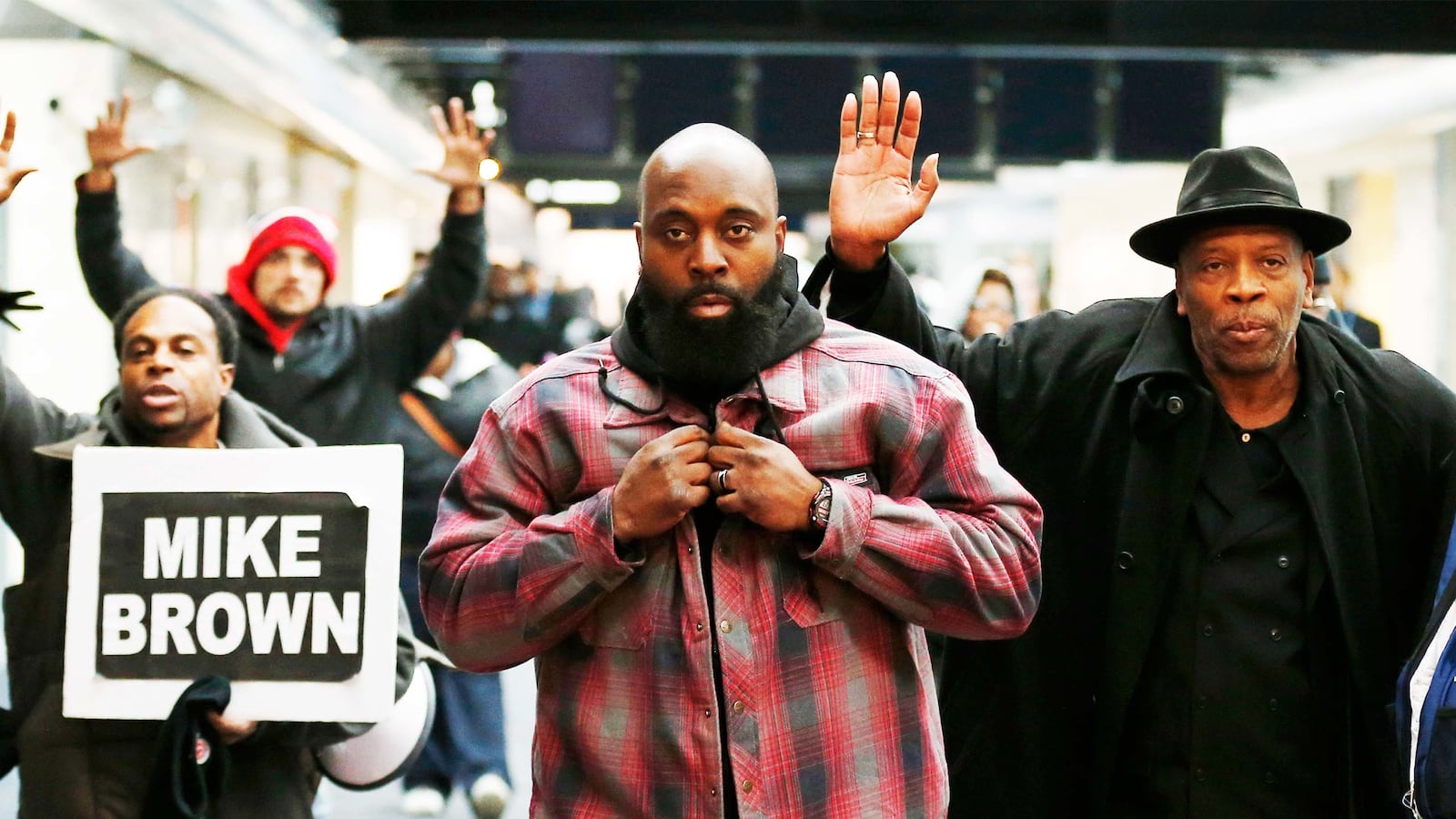AUSTIN, Texas — While the president of the United States is busy whingeing about the rapper Snoop Dogg, a modest film has managed to pique the country’s curiosity.
Jason Pollock’s Stranger Fruit, which debuted at this year’s SXSW, offers a comprehensive—and admittedly one-sided—investigation into the killing of Michael Brown, an unarmed 18-year-old black youth, at the hands of white police officer Darren Wilson. The death of the college-bound Brown sparked months of protests in his home city of Ferguson, Missouri, as well as the chant “hands up, don’t shoot”; Wilson, meanwhile, was not indicted by a St. Louis County grand jury, and cleared of criminal wrongdoing by the Department of Justice.
There are two competing narratives when it comes to Brown’s death. The first, adopted by Wilson and his supporters, is that Wilson had received a call on his radio about a convenience-store robbery involving a package of cigarillos and a man matching Brown’s description. When, at approximately 12:01 p.m. on Aug. 9, 2014, he spotted Brown and his pal Dorian Johnson walking down the middle of Canfield Drive, Wilson stopped them. An altercation ensued, with Brown reaching through the window, punching Wilson, and making a move toward his gun. “I felt like a 5-year-old holding on to Hulk Hogan,” Wilson, who is 6-foot-4 and 210 lbs., said of Brown, who was 6-foot-4 and 292 lbs. Wilson, who further described Brown as a “demon,” then fired his gun twice through his car door, with one of the bullets grazing Brown’s right thumb, causing Brown to flee. Wilson followed, and Brown at some point decided to turn and charge Wilson, running straight into a hail of gunfire. Six of those 10 shots hit Brown, with the sixth and final bullet penetrating the top of his skull—killing him.
It is this narrative that Stranger Fruit attempts to unravel.
Six days after the death of Brown, Ferguson PD released surveillance footage taken at a convenience store that appeared to show Brown, 10 minutes before his death, engaged in a physical dispute with a store clerk. He is seen yanking a package of cigarillos at Ferguson Market & Liquor, and when he does, the clerk comes out from behind the counter and attempts to block his exit. Brown shoves the clerk into a snack display, steps toward him as a show of intimidation, and exits the mini-mart.The Obama administration and Missouri Gov. Jay Nixon condemned the release of the video. “We disagree deeply. I think for two reasons: No. 1, to attempt to in essence disparage the character of this victim in the middle of a process like this is not right. It’s just not right,” said Nixon. “And secondarily, it did put the community, and quite frankly, the region and the nation, you know, on alert again.”
Pollock’s documentary, however, contains previously unseen footage of Brown at Ferguson Market & Liquor less than 11 hours before the scuffle—at 1:13 a.m. In the video, Brown is seen placing a small item on the counter. One clerk puts it to his nose and smells it, before passing it to another clerk, who does the same. It is not clear where the item ends up. While this is happening, a clerk is bagging a package of cigarillos and drinks, and hands the bag of goods to Brown. As Brown is leaving the store, words are exchanged, and Brown returns the bag to the clerk, who restocks the items. According to Pollock, Brown had bartered a small amount of marijuana for the cigarillos, and the following day went to retrieve them. The older clerk was not aware of the deal, leading to the confrontation. In short: No robbery occurred, and if no robbery occurred, then Michael Brown was killed over walking down the middle of a street.
This type of bartering for goods, Pollock says, was commonplace at Ferguson Market & Liquor. “We asked everyone in the community, without revealing the videotape, about the store. They said there are drug deals in the store all the time, people have been murdered outside the store, the store’s been shot at. The store is shady as shit,” Pollock tells me.
St. Louis County Prosecuting Attorney Bob McCulloch called the tape “just stupid” and a “poorly edited snippet,” before claiming: “There was certainly an attempt to barter for these goods, but the store employees had no involvement at all in that. When [Brown] left, they put everything back on the counters where they belonged and went about their business.”
Brown’s father, Michael Brown Sr., doesn’t see it that way. I’m seated across from him at a hotel in downtown Austin. His voice vacillates from shaky to resolute; his face etched with tragedy. Brown Sr., 39, is currently embroiled in a wrongful-death lawsuit against Wilson, Chief Jackson, and the City of Ferguson. The case is set to go to trial in May.
“I’m still going through a civil suit, so I have to watch what I say,” he says, weighing his words. “For the protesters and everyone else that was out there fighting for justice, it was a smack in the face that they felt they needed to do something, but now they know they were right. There was a piece missing. We, as his family, it’s a big pill to swallow because being his father, I know him and I know he didn’t make no move like that. I know it had to be something else. So to really get knowledge from that extra film, it’s like, damn, Mike is still working from the grave, man.”
He pauses. “It really just gives the chance to show the public that you can scratch that ‘demon’ off, and you can write ‘angel.’”
The working title for Pollock’s film was Ferguson Cover-Up. And Pollock, a protégé of Michael Moore’s who contributed to his doc Fahrenheit 9/11, says that he moved to Ferguson shortly after the St. Louis County grand jury’s November 2014 ruling not to indict Wilson, and has been collaborating with the Brown family on the documentary since May 2015.
Brown Sr., who says the film is “powerful, heartbreaking, and will make you angry,” is especially careful when discussing the man who took his son’s life. He says that he doesn’t buy Wilson’s story for a second. “He was prepped, you know? Someone took out time for him to teach him what to say, to be a great liar,” says Brown Sr.
Communities need to be policed, he adds, by people who live within the community itself, and have an intimate knowledge of its people—not those like Wilson, who lived 20 miles outside of Ferguson. “You have to hire people who have been around black people,” he says. “You can’t just be hiring some bootheel people who have never been around a different race. They don’t know how to act!”
When I ask Brown Sr. to share memories of his son, a rare smile creeps onto his face. “Mike was a funny, loving, big guy. Cracked a lot of jokes. He was a prankster. He just was an average teenager, man. He liked having fun, he liked the girls, and he liked what teenagers like,” he recalls. “He was at the prime of learning himself. Between the ages of 18-21, you don’t really know yourself—you’re still in the process of learning. They think that they are grown though, but they’re still learning. He was just trying to find his way.” His voice quivers. “I miss him, man. He was the best man at my wedding [to his second wife]. It was July 16, a few weeks before he died. There were a lot of intimate moments that we shared that I can pull out and get a smile on my face. The anger comes from not being able to see him. I wanted him to eventually have kids, but all those dreams are just flushed. You are put on this earth to protect your child, and if you’re not there to protect your child, you take the blame. It’s just human nature.”
This brings us to the second narrative concerning Brown’s death, one adopted by Brown supporters, as well as Stranger Fruit. The film, citing grand jury testimony from the first arriving sergeant on the scene, as well as a press conference statement by Ferguson PD Chief Jackson, argues that Wilson was not aware of the robbery at all, and instead performed a “pedestrian check” on Brown and Johnson for walking down the middle of Canfield Drive. Wilson was acting as the aggressor, and grabbed Brown through his car window, prompting a scuffle between the two. Wilson then fired his gun twice through the car door. Brown fled, and made it about 174 feet before he was hit in the arm by a bullet. He then spun around, and, with his hands partially raised in an attempt to surrender, was shot five more times. The 21 feet and 7 inches between blood stains on the street and Brown’s corpse, the film argues, did not indicate that Brown was charging towards Wilson, but rather stumbled forward seven or so steps before dropping dead.
“I just really want the public and everyone who showed the Brown family support to know that what they did by putting their life on the line for Mike Brown and what they believe is right was not in vain. And my son’s death was not in vain,” says Brown Sr. “I want those people to know that I appreciate them.”






